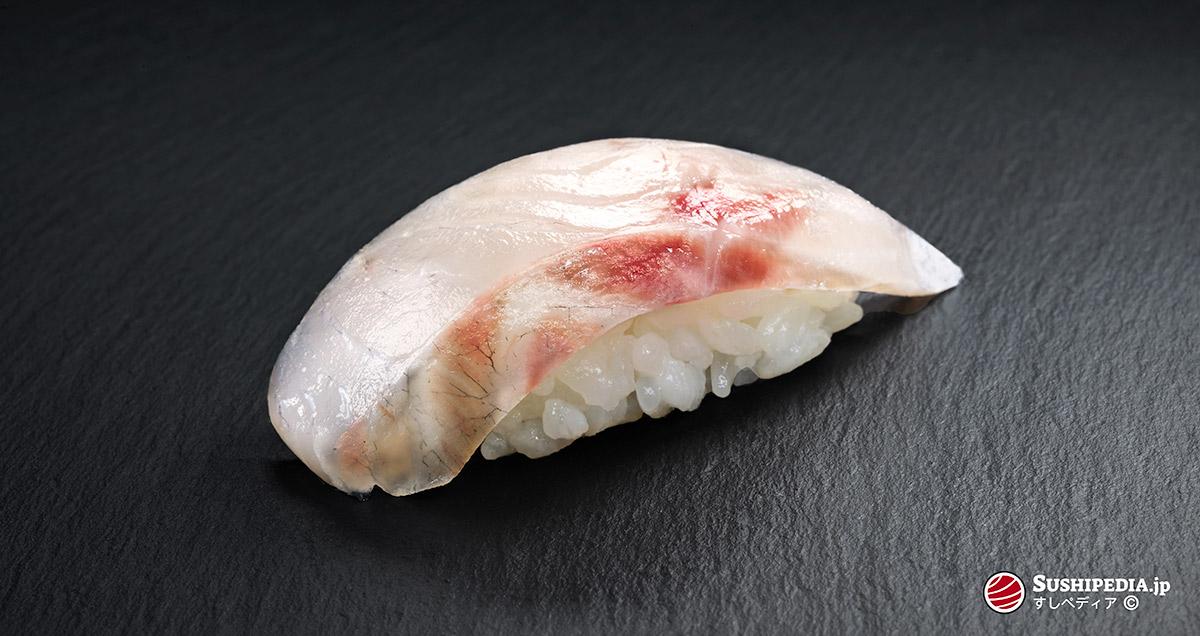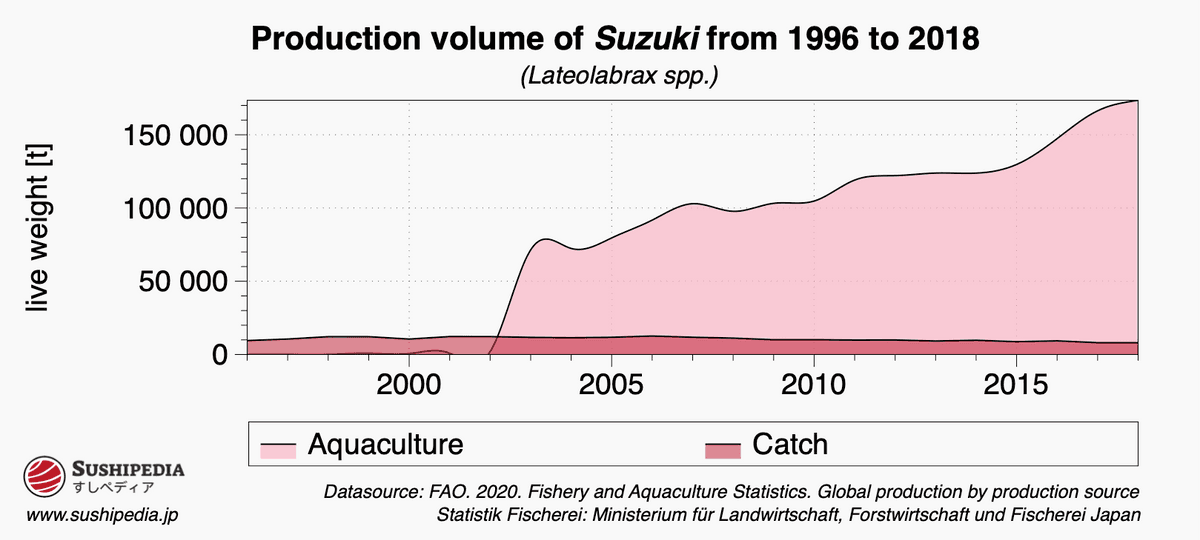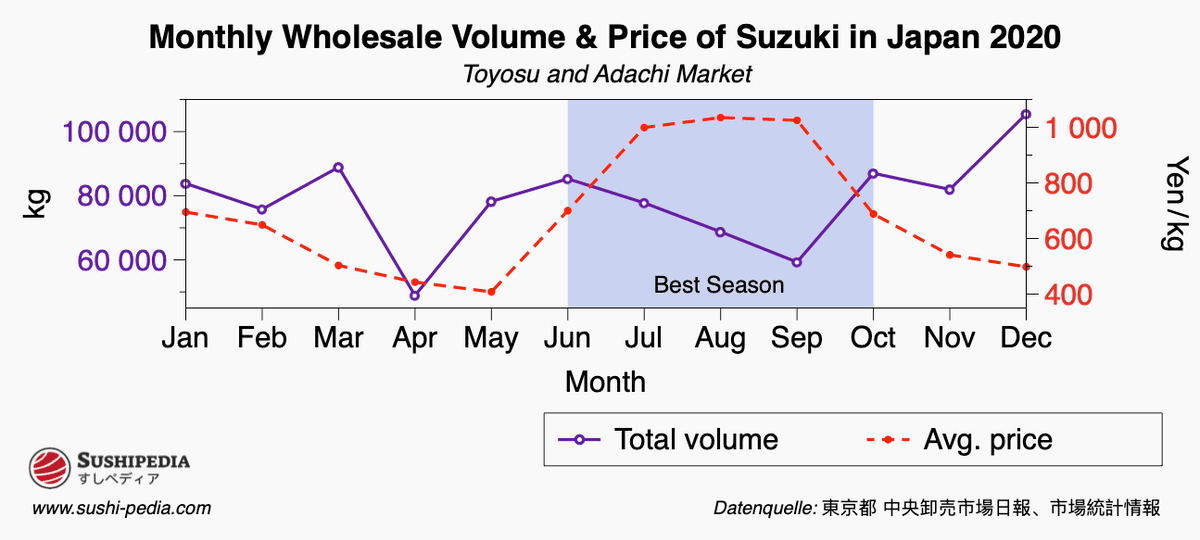Suzuki Sushi
Japanese Sea Bass

What is Suzuki (Japanese Sea Bass)?
Suzuki is the Japanese name for the japanese sea bass, a species of perch-like fish found in the Western Pacific and coastal rivers.
Japanese sea bass is one of the traditional ingredients for edomae sushi. In Japan, however, there are many fish that have the designation suzuki as part of their name, or more accurately, are part of the suzuki-family (スズキ目). Especially outside Japan, some closer and less closely related species are used to make suzuki sushi.
Suzuki as Ingredient for Sushi or Sashimi
The white meat is remarkably bright, almost without blood, firm but still tender. Its appearance is similar to the meat of the red sea bream (tai). Suzuki has a light and refreshing distinctive taste which makes it one of the most popular fish in summer.
Suzuki is not only excellent for sushi and sashimi, but also for arai (洗い). For this, the raw meat is cut very thinly, soaked in ice water and then served with a refined soy sauce or a miso vinaigrette.
Avoid suzuki caught in rivers or brackish water of dirty or polluted rivers. Not only does the meat have a bad smell and a miserable taste, but suzuki may also be contaminated with harmful substances.
Best season
The spawning season is between November and April, which means that the period from May to October, which has its peak in June to August, is considered the best season for suzuki. Before spawning the adult animals visibly increase in fat and are therefore more palatable.
In some regions of Japan suzuki is caught in winter (samu suzuki, 寒スズキ). During the cold season the fish migrate to bays near the coast to spawn. Fish that have not yet spawned at this time are considered top specimens and are traded at high prices.
Suzuki in Japan
There are different theories about the origin of the name suzuki, one of them says that the name is derived from the Japanese term susugi (ススギ). Susugi is the Japanese word for rinse and is a metaphor for the white and clean-looking flesh of the suzuki, which looks as if it has already been washed out.
A Fish That Changes its Name
Suzuki is a fish that changes its name when it grows (shusseuo, 出世魚). The custom has its origins in the Edo period and was part of the ceremonial rite of passage into adulthood. At that time, it was common for aspiring warriors and scholars to change their names when they rose to the rank.
| Region | Small | Medium | Large |
|---|---|---|---|
| Kanto |
Seigo
セイゴ |
fukko
フッコ |
suzuki → ootarou
スズキ → オオタロウ |
| Kansai |
Seigo
セイゴ |
hane
ハネ |
suzuki
スズキ |
| Tokai |
Seigo
セイゴ |
madaka
マダカ |
suzuki
スズキ |
Characteristics & Ecology of Suzuki (Japanese Sea Bass)
Suzuki prefers rocky coastal regions which are exposed to strong currents and swell. In winter they spawn and hibernate in bays and estuaries influenced by the open sea. Suzuki are hermaphrodites (double sexed individuals), which reach sexual maturity as males and change to the female sex in the course of their life.
The distribution area stretches from the coasts of the Japanese archipelago from southern Hokkaido to Kyushu, as well as in the east and south of the Korean peninsula. Suzuki is considered to be predominantly nocturnal and feeds on small fish and crustaceans.
Beside Japanese sea-perch (suzuki), two further relatives of its type exist. The spotted Japanese sea bass (tairikusuzuki) was until not too long ago regarded as the same species as suzuki. It is believed that tairiku-suzuki specimens escaped from Chinese breeding facilities in the 1990s and have since settled in Japan. Based on concerns about habitat competition with Suzuki and other fish, tairiku-suzuki was classified as a non-native species by the Act to Prevent Damage to the Ecosystem by Certain Alien Species (平成十六年法律第七十八号特定外来生物による生態系等に係る被害の防止に関する法律). Blackfin sea bass (hirasuzuki) is also a popular edible fish and is valued for sushi and sashimi. The (ariakesuzuki) is a regional variety that has not yet been sufficiently studied scientifically.
Classification
Classification of the “suzuki group” can be subject to different opinions. On the one hand the classification as suzuki is only used for perches that are native to Japanese waters, but on the other hand also species like the European sea bass carry suzuki in their japanese name.
Furthermore, the taxonomic order of the Percoidei carries the Japanese common name suzukiamoku (スズキ亜目). Their most representatives, however, are not called suzuki.
Economy
The main Japanese fishing grounds of suzuki are Tokyo Bay, Ise Bay, the Seto Inland Sea and Lake Ariake, where they are caught mainly with bottom-set gillnets. Since the mid-2000s, large quantities of tairikusuzuki have been bred in aquaculture in China, Taiwan and South Korea.


Video about Suzuki
External video embedded from youTube.com: さばけるチャンネル. 鱸(すずき)のさばき方 - How to filet Japanese Seaperch -|日本さばけるプロジェクト
Distribution Area of Suzuki
Source: Kaschner, K., Kesner-Reyes, K., Garilao, C., Segschneider, J., Rius-Barile, J. Rees, T., & Froese, R. (2019, October). AquaMaps: Predicted range maps for aquatic species. Retrieved from https://www.aquamaps.org. Scarponi, P., G. Coro, and P. Pagano. A collection of Aquamaps native layers in NetCDF format. Data in brief 17 (2018): 292-296.
Warnings Regarding Suzuki Sushi or Sashimi
- PARASITES: The meat, especially that of wild-caught specimens, may be infested with parasites that cause infectious diseases. Infection can be avoided if the raw meat has been adequately frozen. Pickling and soaking in salt or vinegar solution is not sufficient to eliminate the parasites. If the product has been farmed, only raw unprocessed seafood from production facilities whose products are approved for raw consumption should be consumed. [FDA, 2021]
Species of Suzuki
The following species are regarded as authentic. Either historically, according to the area of distribution or according to the common practice in today's gastronomy:
Japanese Name | Common Names, Scientific Name |
|---|---|
hirasuzuki, tairikusuzuki ヒラスズキ、タイリクスズキ | blackfin sea bass Lateolabrax latus family: Lateolabracidae |
suzuki, fukko スズキ、フッコ 鱸 | Japanese sea bass, Japanese seaperch, asian sea bass Lateolabrax japonicus family: Lateolabracidae |
The following species can be considered subsitutes. Either on the basis of genetic relationship or because they are similar in taste or appearance:
Japanese Name | Common Names, Scientific Name |
|---|---|
tairikusuzuki タイリクスズキ | spotted Japanese sea bass Lateolabrax japonicus maculatus family: Lateolabracidae |
yoroppasuzuki ヨロッパスズキ | European bass, European sea bass, bass Dicentrarchus labrax family: Moronidae |
References & Further Reading
- [Froese & Daniel, 2019]: Rainer Froese, Pauly Daniel. FishBase. The Leibniz Institute of Marine Sciences at the University of Kiel, FishBase.org. 2019. https://www.fishbase.org. Retrieved online on December 24, 2020.
- [Fujiwara, 2020]: 昌髙藤原. ぼうずコンニャクの市場魚貝類図鑑 (engl. Bozu Konyaku's Market Fish and Shellfish Book). Bozu Konnyaku Co., Ltd., Tokyo ぼうずコンニャク株式会社東京, zukan-bouz.com. 2020. https://www.zukan-bouz.com/. Retrieved online on December 27, 2021.

